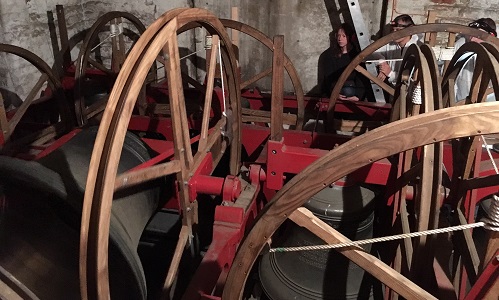Bell Maintenance - 10 Nov 2018
It was a fine November morning when seven ringers turned up at All Saints Church in the centre of Northampton for a Bell Maintenance workshop hosted by the Northampton Ringing Hub. We were a mixed bunch of interested ringers and steeplekeepers (themselves encompassing volunteers, pressed men and novices) - but all keen to learn more about the maintenance of bells.
The hosts (Jennie and Giles) wore their broad knowledge lightly and had put together an absorbing programme which covered both the theoretical aspects of approaching bell maintenance (including the inevitable Health & Safety risk assessments) balanced with visits to two contrasting bell installations.
The day started with some discussion of Health & Safety issues in bell towers - kept relevant and engaging by their knowledgeable anecdotes and experiences. This included advice on how to approach risk assessments. Lively discussion and relevant examples ensured that this did not become the 'dry as dust' lecture that (I personally) had anticipated! This was followed by a session on typical problems encountered rounded off by climbing the tower to examine the ring of 10 bells at All Saints. Having been installed in 2006, this was practically brand new in bell terms - brightly painted steel frame with all the fitting still quite shiny.
Lunch (which seemed to coincide with the monsoon in Northampton) was followed by some suggestions on scheduled maintenance and then a visit to a second tower (St Peters). These bells dated from the 18th century and (being in a church no longer used for regular worship) provided a marked contrast to All Saints being in a very cramped wooden frame.
The day wrapped up with a tea break (sorry - an in depth question and answer session) back at All Saints before we all departed homewards.
So what was my overall impression of the day? Well, the content is obviously very useful; knowing something about risk assessment and scheduled maintenance planning is clearly very useful when beginning to set something up in your home tower. But for me the most valuable part was the chance to talk to (and pick the brains of) other ringers with some experience in this field. Being in their home tower(s), Jennie and Giles were able to set a lot of the theoretical points in a practical context. Plus the chance to listen to other people and hear something about the difficulties and frustrations that they had encountered was very interesting. In addition, the chance to see (at close quarters) two such contrasting installations was fascinating and instructive.
The day would clearly be of use to any new or novice steeplekeeper but, more broadly, would be of interest to anyone wanting to know a bit more about the mechanics of how bells are set up for ringing. If that sounds like you then I'd recommend it unreservedly.
Mick Fuller
PS - In case you were in any doubt - I really enjoyed the day - lots of useful stuff. All I've got to do now is to start doing it!

Safety Note: You can see in the picture above that measures have been taken to manage the Health & Safety risks in the belfry (the area is well lit, people are well clear of the swinging bell, the other bells are down, ear protection is being worn … etc.)
Course Tutor: Jennie Higson
» What is a Bell Maintenance Workshop?